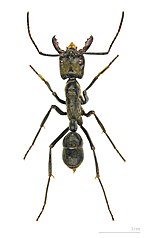Paraponera clavata, commonly known as the bullet ant, is a species of ant known for its extremely painful sting. It inhabits humid lowland rainforests...
24 KB (2,637 words) - 01:27, 19 August 2024
species: the extant Paraponera clavata, also known as a bullet ant, found in the Neotropics, and the very small fossil species Paraponera dieteri known from...
4 KB (243 words) - 06:51, 29 September 2024
most painful stings; in the original paper, only the bullet ant, Paraponera clavata, was given a rating of 4. Later revised versions of the index added...
15 KB (1,767 words) - 19:20, 16 September 2024
Poneratoxin is a paralyzing neurotoxic peptide made by the bullet ant Paraponera clavata. It prevents inactivation of voltage gated sodium channels and therefore...
13 KB (1,415 words) - 09:16, 29 April 2024
giant Amazonian ants. These ants are generally less well known than Paraponera clavata, the bullet ant, yet Dinoponera females may surpass 3–4 cm (1.2–1...
17 KB (1,931 words) - 15:16, 18 September 2024
Borgmeier in 1958. This species is a parasitoid of the giant tropical ant Paraponera clavata (commonly known as the bullet ant) and uses both visual and chemical...
11 KB (1,340 words) - 17:49, 1 July 2024
species this researcher rated as having a more painful sting were Paraponera clavata (bullet ant), Synoeca septentrionalis (warrior wasp), and Pepsis and...
20 KB (2,260 words) - 14:40, 22 October 2024
causes severe pain but is still not life-threatening. The bullet ant (Paraponera clavata) injects a venom which contains a neurotoxin named poneratoxin which...
48 KB (5,651 words) - 07:06, 4 October 2024
the painfulness of its sting, falling short of only the bullet ant (Paraponera clavata), the warrior wasp (Synoeca septentrionalis), and the tarantula hawk...
7 KB (559 words) - 16:45, 11 August 2024
have toxic venom and are of medical importance. The species include Paraponera clavata (tocandira) and Dinoponera spp. (false tocandiras) of South America...
155 KB (17,319 words) - 03:48, 5 November 2024










